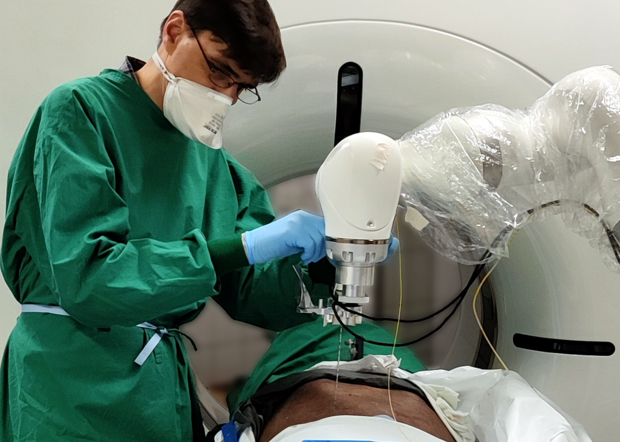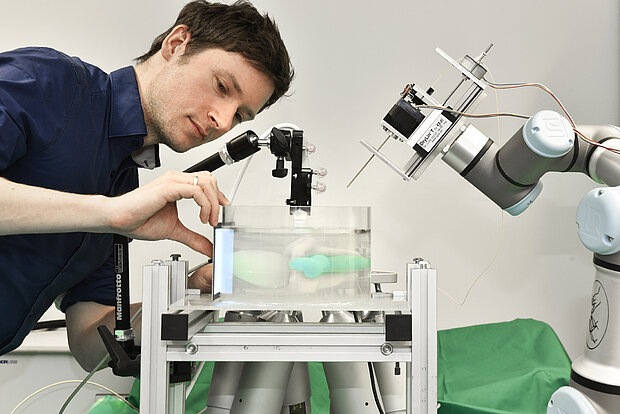Robotics and Navigation
We explore methods for controlling robots that can compensate and predict motion or to interact with the user through haptic feedback, particularly in the context of medical applications. We design intelligent robotic systems that enable high-precision positioning with custom sensors and image guidance. Further, we are interested in mobile robotics with a focus on fully automated navigation of a robot in a clinical environment. Serial and parallel robots are a cornerstone of our experiments, ensuring high precision and reproducibility in all our research areas: navigation, machine learning and optimization.
Selected publications
- M. Neidhardt, S. Gerlach, R. Mieling, M.-H. Laves, T. Weiß, M. Gromniak, A. Fitzek, D. Möbius, I. Kniep, A. Ron, J. Schädler, A. Heinemann K., Püschel, B. Ondruschka, A. Schlaefer (2022). Robotic Tissue Sampling for Safe Post-Mortem Biopsy in Infectious Corpses. IEEE Transactions on Medical Robotics and Bionics. 4. (1), 94-105 [Abstract]
[doi][www][BibTex]
- R. Mieling, C. Stapper, S. Gerlach, M. Neidhardt, S. Latus, M. Gromniak, P. Breitfeld, A. Schlaefer (2022). Proximity-Based Haptic Feedback for Collaborative Robotic Needle Insertion. In Seifi, Hasti and Kappers, Astrid M. L. and Schneider, Oliver and Drewing, Knut and Pacchierotti, Claudio and Abbasimoshaei, Alireza and Huisman, Gijs and Kern, Thorsten A. (Eds.) Haptics: Science, Technology, Applications Springer International Publishing: Cham 301-309 [Abstract]
[BibTex]
-
M. Schlüter, L. Glandorf, M. Gromniak, T. Saathoff, A. Schlaefer
(2020).
Concept for Markerless 6D Tracking Employing Volumetric Optical Coherence Tomography.
Sensors.
20
(9),
2678.
[Abstract][doi][BibTex]
-
M. Schlüter, C. Fürweger, A. Schlaefer
(2019).
Optimizing Robot Motion for Robotic Ultrasound-Guided Radiation Therapy.
Physics in Medicine & Biology.
64
(19),
195012.
[Abstract][doi][BibTex]
-
A. Schlaefer, A. Schweikard,
(2008).
Stepwise multi-criteria optimization for robotic radiosurgery.
Med Phys.
35
(5),
2094-2103.
[Abstract][doi][BibTex]
Collaborative Robotics
We develop robotic systems that combine sensing with real-time data processing through machine learning to enable precise positioning of a medical tool with a robot. Customized sensors and haptic feedback enable the user to perceive new or enhanced sensations, for example, allowing the surgeon to feel tissue transitions during collaborative procedures. We typically test our systems in our laboratory and with clinical physicians.
We have also demonstrated our methods at the KUKA Innovation Award 2020 where we presented collaborative robotics and specialized sensors among fellow researchers.
Motion Prediction and Compensation
With our high-frequency ultrasound, optical coherence and optical tracking systems, we are able to systematically analyze motion and compensate for displacements by real-time data processing. Predicting movements and compensating them with a robot is one of our research areas, e.g. for continuous compensation of head movements during transcranial magnetic stimulation.
In addition, we are adressing motion compensation in needle-based procedures such as biopsy or brachytherapy, which require precise and safe placement of needles in soft tissue. Tissue deformations and bulk displacements demand new ideas to reliably reach the target structure, and we are investigating how robotic needle drivers and externals can improve placement accuracy.
Mobile Robotics
One of the key advantages of brachytherapy is the application of dose from within the tumor. Hence, surrounding organs can be spared effectively, e.g., by placing small radioactive seeds in a needle in HDR brachytherapy. However, as the dose gradient around the seed is steep, it is important to place the needles precisely.
We study the use of robotics in combination with sensors and advanced imaging to analyze the needle position with respect to the tissue.
Our Robotics Laboratory
We have several robots in our lab ranging from highly accurate positioning of a medical tool (<0.01mm) to real-time interaction (1000Hz control loop) with a user. We also have a number of high frequency navigation systems (e.g., optical and electro-magnetic) for experimental setups. In conjunction with our navigation research we develop smart robots that can sense their environment fully automatically.
Contact
- Alexander Schlaefer (schlaefer(at)tuhh.de)
- Robin Mieling (robin.mieling(at)tuhh.de)
- Maximilian Neidhadrt (maximilian.neidhardt(at)tuhh.de)

